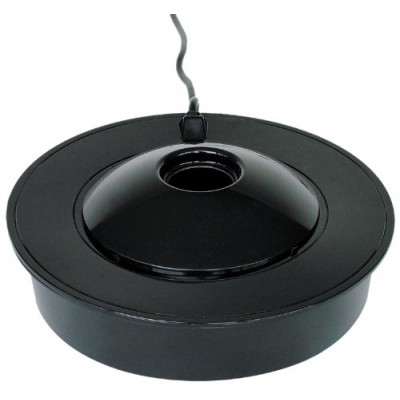Pond Pumps Canada is part of the Amazon Affiliate Network. We may receive payment for items purchased through the Amazon website.
Uses only 100 watts. Maintains a hole in backyard pond ice for just pennies a day. Floats on top of the water. Thermostatically controlled never to get hot. Completely safe. Fish friendly - assists the escape of toxic gases all winter long. Tested in northern Wisconsin at temperatures of 30 below zero Fahrenheit. UL and CMET listed. Warranty: One year limited. 12 in. Dia. x 4 in. H. The world's most successful and efficient low-wattage pond de-icer. For ponds up to 1000 gallons! The world's most energy efficient pond heater! Thermo-Pond is a unique patented pond heater that keeps a hole through the ice in backyard ponds for just pennies a day. In fact, Thermo-Pond can save up to $30.00 a month in electricity VS. those high wattage stock tank style de-icers! Just think, Thermo-Pond pays for itself in as little as 2 months. Unlike some other heaters, Thermo-Pond will never burn a pond liner or plastic pond. It naturally allows the pond to ice over while maintaining a hole through the ice. Thermo-Pond should be used in ponds that are deep enough to allow plenty of livable water under the iced portion of the pond.
- The world's most successful and efficient low-wattage pond de-icer
- Uses only 100 Watts and maintains a hole in backyard pond ice for just pennies a day
- Floats on top of the water and is completely safe when used with a pond liner or plastic pond
- Fish friendly - assists the escape of toxic gases all winter long to help maintain a toxic-free environment for fish living under the ice
- Tested in northern Wisconsin at temperatures of 30° below zero Fahrenheit and is MET Listed
K&H Manufacturing 8001 Thermo-Pond 3.0 Floating Pond 100-Watt De-Icer
- Brand: K&H Manufacturing
- Product Code: 8001
- Availability: In Stock
Related Products
Aquascape 75001 Pond Air 4 (Quadruple Outlet Aeration Kit)
Aquascape 4-Outlet Pond Aerator Aeration 75001 Pond Air 4 ae..
Aquascape 75001 Pond Air 4 (Quadruple Outlet Aeration Kit)
Aquascape 4-Outlet Pond Aerator Aeration 75001 Pond Air 4 ae..
Airmax Eco-Systems 001040 Pondair Four Stone Pond Aerator
Airmax PondAir 4 Aeration Kits will increase oxygen for your..
Dynamic Head
The effect of the Earths gravity on the "lift" or head pressure is fairly simple; for every vertical foot of distance the pump moves the water you are adding one foot of head pressure so the ratio is a 1:1 ratio. The effects of the friction, caused by water as it travels through your hose or pipes, on the total head pressure is a little more difficult to calculate especially as there are slight variations in pipe friction in different hose materials and the smoothness of the inner bore. Basically. for every ten feet of pipe through which the water has to travel travel horizontally will contribute 1 foot of head height; the ratio of the pipe friction loss is a 10:1 ratio.Plumbing fixtures and bends and corners in your hose also increase the total head you must calculate to ensure the proper final volume from your pump. Every corner with a 90 degree elbow in your plumbing will add 1 foot of head pressure with a 1:1 ratio. 45 degree elbows, tees and even insert couplers can all have an impact on the final flow.
If you install a pump 40 feet away from the top of your waterfall which is 6 feet above the pump and the tubing is a single run of 40 feet horizontally then you add 4 feet of head for the tubing length (the 10:1 ratio) to the 6 foot differnetial between the pump location and the final height of the waterfall so your final total dynamic head calculation would be 10 feet. This means your final volume of water flow in this water feature or application would be the volume of flow on the performance curve that equaled the gallons per hour at 16 feet. This volume will certainly be much less than the initial volume the pump can move at an open flow or a zero head.
If in the above example your 40 feet of horizontal tubing run also required 3 elbows of 90 degrees then an additional 3 feet of theoretical head would be added and your final flow result would be at 19 feet on the performance curve of the pump. In this example you would want to choose a pump that has the desired GPH rating at 9 feet of head pressure. Tubing size is also an important factor in accounting for head pressure loss, in general you should never reduce the diameter of the tubing below what the output size of the pump is, this will drastically increase head pressure, and reduce pump performance. For maximum pump performance, using the largest tubing that is practical is the best choice. A best practice is to use a hose with an inner diameter that is the same as your pumps outlet fitting.

